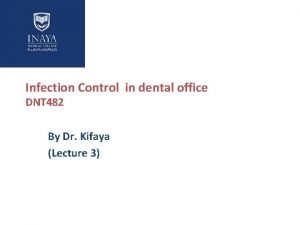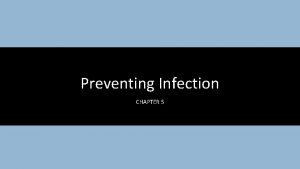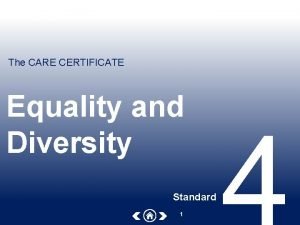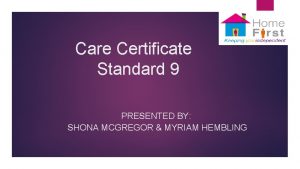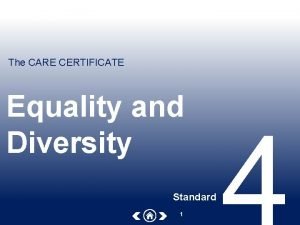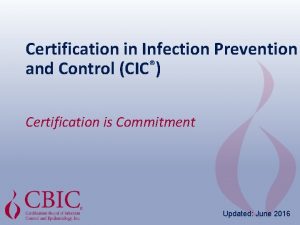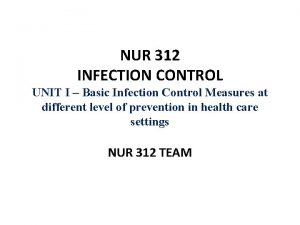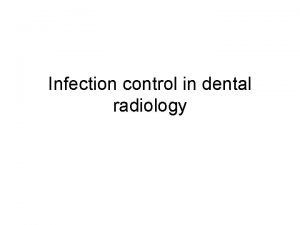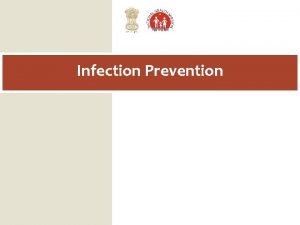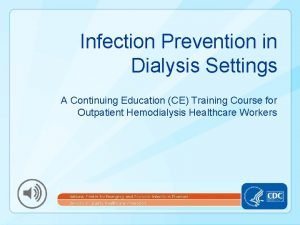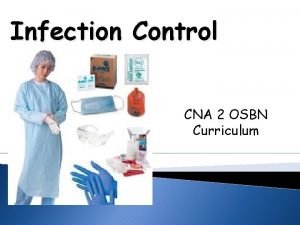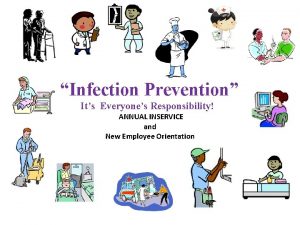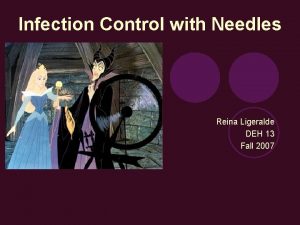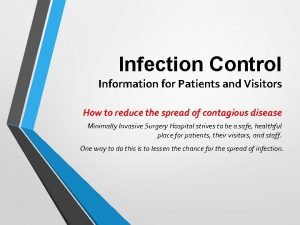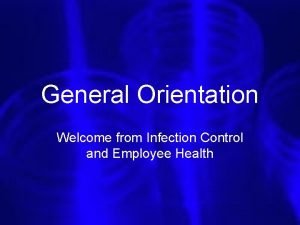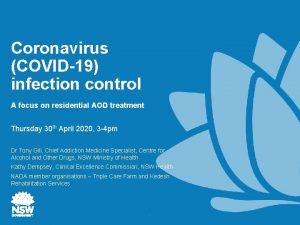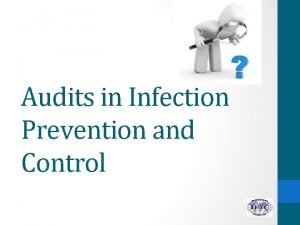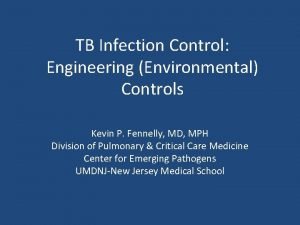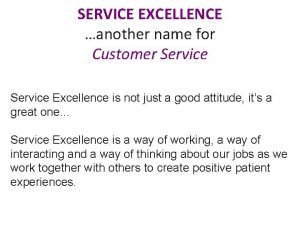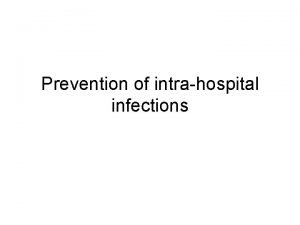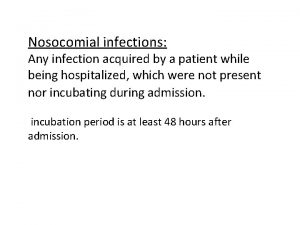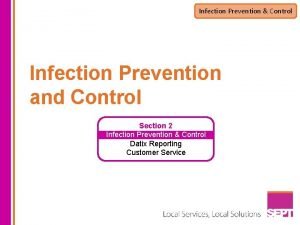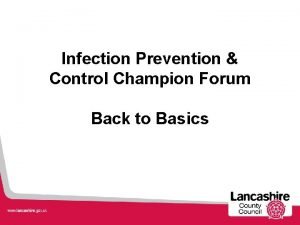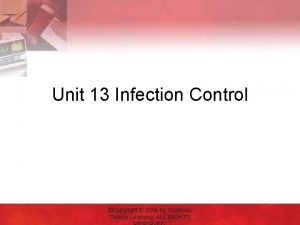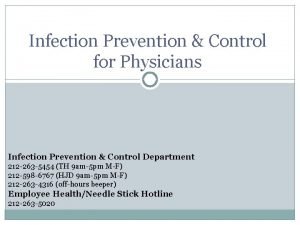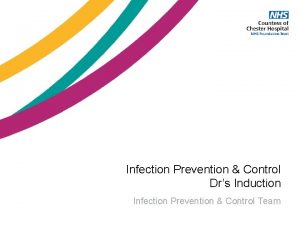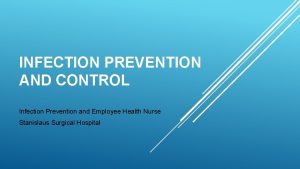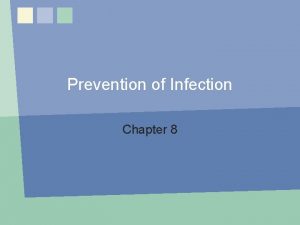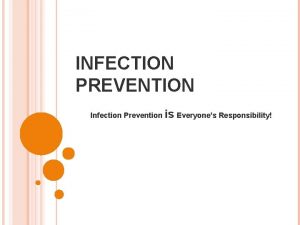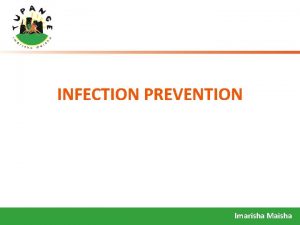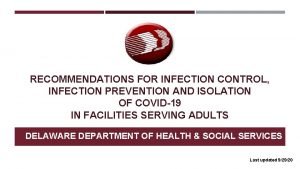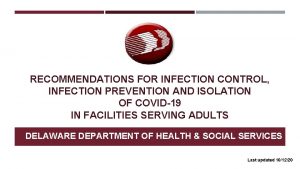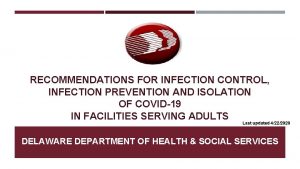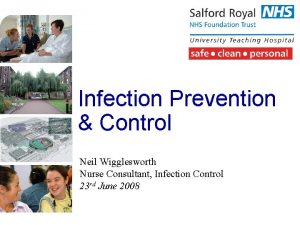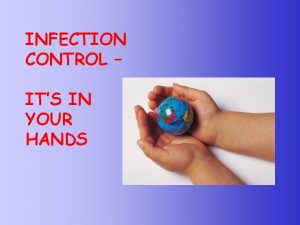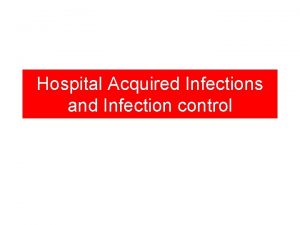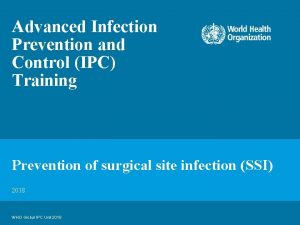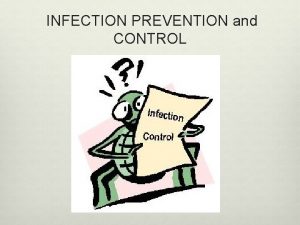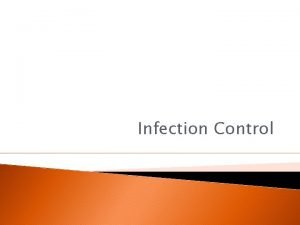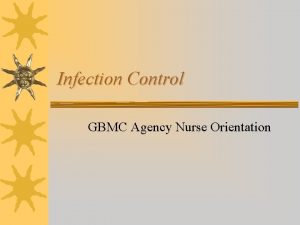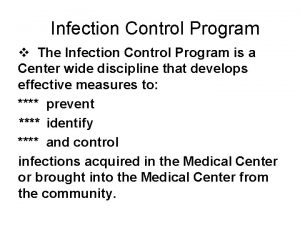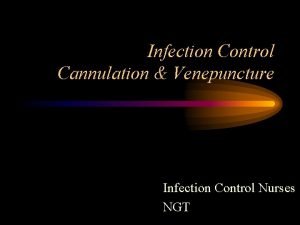Care Certificate Standard 15 Infection Prevention and Control







































- Slides: 39

Care Certificate Standard 15 Infection Prevention and Control

Housekeeping Toilets Mobiles Smoking Breaks Fire

Aims and objectives For Standard 15, you must be able to: Describe the main ways infection can get into the body and can be transmitted to others Demonstrate effective hand hygiene. Explain how own health can pose a risk to others. List common types of protective clothing, equipment, procedures and how and when to use them. Explain the principles of safe handling of infected or soiled linen and clinical waste. Have knowledge of ACS infection prevention and control procedures

What is an infection? � The invasion of an organism’s body tissue by disease-causing agents, their multiplication and the reaction of host tissues to these organisms and the toxins they produce. � An infection may cause no symptoms (subclinical) or it may cause symptoms and be clinically apparent

Infection Control Quiz

http: //wwwbbc. . co. uk/programmes/p 0 11 lqzt. BBC Two - Inside the Human Body - Learning Zone - Clips

Infection Facts � Healthcare Associated Infections (HCAI) pose a significant risk to patients, carers and staff: � Around 30, 000 patients develop a HCAI each year � An estimated 5000 patients die each year as a result � 15 – 30% of HCAI are preventable � Prevention is the key priority � This can be achieved by training and awareness

Chain of infection 1 2 6 5 3 4

If you are ill � If you have cold or flu symptoms (such as a runny nose), an upset stomach or skin infections, you should speak to your manager before reporting to work. � If you have diarrhoea or vomiting you should not attend work until you have been free from symptoms for 48 hrs.

Health & Hygiene � It is your responsibility to keep up to date with your own vaccinations. � If you wish to have a flu vaccine keep the receipt and we will reimburse you

� What leads to the spread of infection? Poor hand washing � Incorrect use of or no PPE � Poor food preparation � Poor cleaning practices � Dealing � Lack with ‘sharps’ or bodily fluid incorrectly of training

�Prevention – is attempting to reduce or deter hazards and risks of infection. �Control – is about measures we take to reduce the spread or potential for infection.

Prevention and control is everybody's responsibility

Personal hygiene � Personal hygiene is extremely important for people who care for others. Daily washing, showering or bathing will remove most of the micro-organisms on your skin. � Hand hygiene is also extremely important. Fingernails should be kept short. Remember from ‘Understanding your role’ that rings (apart from plain wedding bands), wristwatches or bracelets should not be worn as they can make handwashing less effective and can cause injury to frail skin

Skin health � Micro-organisms can live on the skin. The number of pathogens increases when skin is damaged. � All cuts should be covered with a waterproof brightly coloured dressing. � Using hand cream, good quality paper towels and soaps can help protect the skin and provide a barrier protection when washing hands often

The world health organisation has identified ‘ 5 moments’ when health and social care workers should clean their hands : � 1. Before touching the individual you are supporting. � 2. Immediately before carrying out a ‘clean’ procedure (ie food preparation) � 3. After exposure to body fluids and after removing gloves. � 4. After touching the individual you are supporting. � 5. After touching the area or objects surrounding the individual you are supporting.

Hand hygiene Lightbox activity

Good hand habits � Having good hand habits means not touching areas that can be a source of pathogens more than you need to. � These areas include your nose, hair and mouth, and not biting your nails. � This applies to work practices such as using foot operated bins rather than lifting bin lids with your hands.

Handwashing � For handwashing to be effective it is important that you make sure that every part of your hands are carefully washed, rinsed and dried. � The steps below show you how to ensure that your hands are washed correctly.

Handwashing

Handwashing 1. Wet your hands and wrists thoroughly using warm running water. � 2. Apply liquid or foam soap. � 3. Produce a good lather by rubbing your palms together, then interlock your fingers and rub together again. � 4. Rub the palm of your hand ensuring that fingertips and fingernails are cleaned. Ensure that the backs of your hands are lathered and cleaned. � 5. Rub with fingers locked, maintaining a good lather. Ensure your wrists are cleaned. � 6. Rinse hands thoroughly using running water. � Hands and wrists should be thoroughly dried using paper towels or a hand dryer. Rubbing and lathering your hands should take about 20 seconds. �

Personal Protective equipment Single use items should be disposed of safely. Uniforms freshly laundered. Worn appropriately for work only. Without jumpers underneath. Used to protect the client, yourself and colleagues from potential risk of harm


Waste � � � When taking off your PPE remove apron by pulling it away from the body and then remove gloves by pulling at wrists and turning gloves inside out as you pull them off and wrap them in apron, double bag them in plastic bags and dispose of in outside black dustbin, wash hands immediately afterwards Offensive/human hygiene waste is not ‘clinical waste’ or ‘hazardous’ under environmental legislation wearing your PPE place soiled pads in a plastic bag and tie shut then place this bag in another plastic bag and tie shut and place in black dustbin Waste containers should be carefully handled to avoid contamination. Where appropriate you should use PPE to protect you from contamination and infection.

GLOVES � Gloves create a barrier between the carer and the customer � This protects the customer and, along with standard principles, prevents cross infection � Hands should be washed before and after wearing gloves

When should gloves be worn? � � � Immediately before an episode of customer contact or treatment (and removed as soon as the activity is complete) When there is a risk of contact with body fluid (blood, faeces, vomit, urine etc) When changing/disposing of incontinence pads, catheter bags, stoma bags etc. � When cleaning soiled/contaminated areas � When handling soiled linen � If contaminated needles or sharps are found

Aprons � Essential protection for clothing/uniforms from contamination with body fluids � Clean, unused aprons should be stored in a way that prevents contamination � An apron is easily changed – your uniform is not and it is likely you will be wearing your uniform when eating your lunch!

PPE ACTIVITY

Clothing � Your clothing can become contaminated with harmful micro-organisms. Disposable aprons and over-sleeves should be used when handling anything contaminated with body fluids to protect clothes from contamination. � Changing your clothing daily reduces the risk of remaining contaminants being spread to the individuals you provide support for. � Uniforms or work clothing should be washed on a hot wash, then tumble-dried or hot ironed, to kill any bacteria present.

Soiled linen � Linen that comes into contact with workers or individuals can become contaminated with harmful micro-organisms and body fluids. � Linen refers to anything that is made of cloth, including bedding, towels and clothing. � PPE must be worn when handling infected linen as it can transfer pathogens to skin and clothing. � All infected linen (that is contaminated with body fluids) must be washed separately to other items.

Washing of contaminated linen � Clothing can be decontaminated in a 40 – 50 degree wash followed by tumble-drying or hot ironing or by a 60 degree wash � Bedding and towels should be washed in a hot wash to ensure that bacteria are killed � When supporting an individual in their own home you should ask permission to wash infected linen immediately.

Legislation Health and Safety at Work Act 1974 - Both employers and employees are responsible for their own actions in the workplace. All reasonable steps should be taken when carrying out your work duties and all staff should have adequate training. Policies and procedures need to be in place and adhered to. Management of Health and Safety at Work Regulations 1999 - Requires all staff to be provided with adequate training and a set of working instructions for safe working practices. Reporting Injuries Diseases and Dangerous Occurrence Regulation 1995 (RIDDOR) - Employer has responsibility to report any work related accidents or disease which results in serious injury or employee off sick for more than seven days. Food Safety Act 1990 Hazardous Waste Regulations 2005 Control of Substances Hazardous to Health (COSHH)

Employers are responsible for : Assessing risk Providing PPE free of charge Putting procedures in place Ensuring procedures are followed Ensuring employees are appropriately trained • Making sure employees are aware of H+S aspects of their work – posting info, providing supervision • Keeping records • Ensuring that relevant standards, policies and guidelines are available within the workplace. • • •

Employees are responsible for: • • • Reading and following the risk assessment Using PPE effectively as per training Keeping records Reporting concerns Reading notice boards, updates and info provided Employees have responsibilities to: • Self • Colleagues • Employer • Clients/Customers and their families

SHARPS � Customer’s are supposed to deal with their sharps themselves or have assistance from a community nurse but main points to look out for are: � They must be disposed of at the point of use into an approved container � All sharps bins should have the name of the person who assembled it and the date of assembly on the label. The same applies for the person closing the bin. � Bins should not be filled past the full line marked on the bin as sharps can fall out and cause injury. � Use the temporary closure mechanism on the top of the bin when it is not being used, to prevent spillages if the bin is toppled over.

� Always keep bins above floor level to prevent children reaching them � Store bins securely out of the sight and reach of other people who may be present. � Do not pass sharps from one hand to the other � Do not handle sharps more than is essential � Do not put protective covering back on needles � Do not bend or break needles � Do not separate needles or syringes before disposal.

ACS Organisational Policy

Any Questions

 Primary prevention secondary prevention tertiary prevention
Primary prevention secondary prevention tertiary prevention Chapter 16 infection control and standard precautions
Chapter 16 infection control and standard precautions Care certificate 10 answers
Care certificate 10 answers Chapter 16 infection control and standard precautions
Chapter 16 infection control and standard precautions Standard 3 infection control
Standard 3 infection control Puncture resistant container
Puncture resistant container Chapter 19 disease transmission and infection prevention
Chapter 19 disease transmission and infection prevention Chapter 19 disease transmission and infection prevention
Chapter 19 disease transmission and infection prevention Define infection prevention chapter 5
Define infection prevention chapter 5 Care certificate standard 4
Care certificate standard 4 Duty of care care certificate
Duty of care care certificate Standard 9 care certificate
Standard 9 care certificate Care certificate standard 4
Care certificate standard 4 Universal precautions milady
Universal precautions milady Certification board of infection control and epidemiology
Certification board of infection control and epidemiology Hip fracture clinical care standard
Hip fracture clinical care standard Primary, secondary, tertiary care
Primary, secondary, tertiary care Labial mounting
Labial mounting Chapter 15:3 washing hands
Chapter 15:3 washing hands Chapter 15:3 washing hands
Chapter 15:3 washing hands Cic infection control
Cic infection control Infection control meaning
Infection control meaning Darkroom infection control guidelines
Darkroom infection control guidelines Learning objectives for infection control
Learning objectives for infection control Conclusion of infection
Conclusion of infection Neutropenic precautions
Neutropenic precautions Infection control is everyone's responsibility
Infection control is everyone's responsibility Infection control
Infection control Standard precautions nsw health
Standard precautions nsw health Infection control information
Infection control information Infection control orientation
Infection control orientation Infection control
Infection control Infection control audits
Infection control audits Environmental controls infection control
Environmental controls infection control Another name for customer service
Another name for customer service Infection control committee
Infection control committee Conclusion of infection control
Conclusion of infection control Rigid thinking examples
Rigid thinking examples Infection control champion
Infection control champion Unit 13 infection control
Unit 13 infection control




